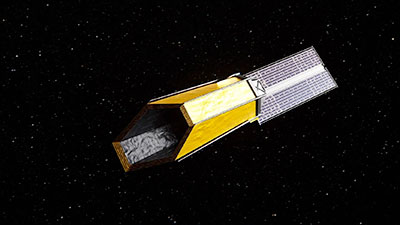|
|

|
|
Author
|
Topic: NASA's Habitable Worlds Observatory (HWO)
|
SpaceAholic
Member Posts: 5351
From: Sierra Vista, Arizona
Registered: Nov 1999
|
 posted 01-10-2023 09:23 AM
posted 01-10-2023 09:23 AM
   
NASA is now planning an optical telescope that would be just as big as the James Webb Space Telescope (JWST) and have a grand new goal: looking for signs of life on Earth-like planets, perhaps by the early 2040s. The telescope will, like JWST, be perched at L2, a gravitational balance point 1.5 million kilometers from Earth. Unlike JWST, it will be designed for robotic servicing and upgrades, which could enable it to operate for decades, getting better with age. Without a dedicated budget, [NASA astrophysics division director Mark] Clampin says he can't yet make much headway on the design and technology. But he does have a working name for the telescope: the Habitable Worlds Observatory (HWO)....with the HWO, NASA is following through on the top priority of astronomy's decadal survey, a community-led wish list that guides funding agencies and lawmakers. The survey's final report, published in November 2021, called for NASA to resurrect its Great Observatories program, which launched the Hubble Space Telescope and several others in the 1990s and early 2000s. The report said an $11 billion, 6-meter telescope sensitive to ultraviolet, optical, and near-infrared wavelengths should kick off the new Great Observatories program. It specified that the telescope, in addition to doing general astrophysics, must be capable of detecting signs of life on 25 nearby Earth-like exoplanets—the minimum needed to confirm statistically whether life is common in the Galaxy. |
Robert Pearlman
Editor Posts: 52468
From: Houston, TX
Registered: Nov 1999
|
 posted 05-31-2024 02:26 PM
posted 05-31-2024 02:26 PM
   
NASA release NASA Awards Advance Technologies for Future Habitable Worlds MissionNASA announced Friday (May 31) it selected three industry proposals to help develop technologies for future large space telescopes and plan for the agency's Habitable Worlds Observatory mission concept, which could be the first space telescope designed to search for life outside our solar system.  Above: This artist's concept features one of multiple initial possible design options for NASA's Habitable Worlds Observatory. (NASA's Goddard Space Flight Center Conceptual Image Lab) The mission would directly image Earth-like planets around stars like our Sun and study their atmospheres for the chemical signatures of life, as well as enable other investigations about our solar system and universe. NASA is currently in the early planning stages for this mission concept, with community-wide working groups exploring its fundamental science goals and how best to pursue them. The agency is also in the process of establishing a Habitable Worlds Observatory Technology Maturation project office at NASA's Goddard Space Flight Center in Greenbelt, Maryland. "The Habitable Worlds Observatory will be a historically ambitious mission, so we are taking a deliberate, strategic approach to its development and laying the groundwork now. We will need to bring together diverse expertise from government, academia, and industry, while building on technologies and lessons learned from our previous large space telescopes," said Mark Clampin, director of the Astrophysics Division at NASA Headquarters in Washington. "With these awards, we're excited to engage industry to help close technology gaps to make this groundbreaking mission a reality." In January 2024, NASA solicited industry proposals to help advance key technologies that will eventually be necessary for the Habitable Worlds Observatory. For example, the mission will require a coronagraph – an instrument that blocks the light of a star so we can better see nearby objects – thousands of times more capable than any prior space coronagraph, and a stable optical system moving no more than the width of an atom during its observations. To help further the readiness of these technologies, NASA has now selected the following proposals for two-year, fixed-price contracts with a combined value of $17.5 million, targeted to begin by late summer 2024: - "Ultra-stable Telescope Research and Analysis – Critical Technologies (ULTRA-CT)"
This project will focus on high-fidelity modeling and subsystem demonstrations to support future development of "ultra-stable" optical systems beyond current state-of-the-art technologies.Principal investigator: Laura Coyle, Ball Aerospace (now BAE Systems) - "Technology Maturation for Astrophysics Space Telescopes (TechMAST)"
This project seeks to advance the integrated modeling infrastructure required to navigate design interdependencies and compare potential mission design options.Principal investigator: Alain Carrier, Lockheed Martin - "STABLE: Systems Technologies for Architecture Baseline"
This project will focus on maturing technologies that support telescope features, such as a deployable baffle and a structure to support the optical train, while mitigating the impact of system or environmental disturbances.Principal investigator: Tiffany Glassman, Northrop Grumman
This work will continue industry involvement started in 2017 under NASA's "System-Level Segmented Telescope Design" solicitations, which concluded in December 2023. The new selected proposals will help inform NASA's approach to planning for the Habitable Worlds Observatory, as the agency builds on technologies from its James Webb Space Telescope and future Nancy Grace Roman Space Telescope and identifies where future investments are needed. | |
Contact Us | The Source for Space History & Artifacts
Copyright 1999-2024 collectSPACE. All rights reserved.

Ultimate Bulletin Board 5.47a
|
|

|
 advertisement advertisement

|












